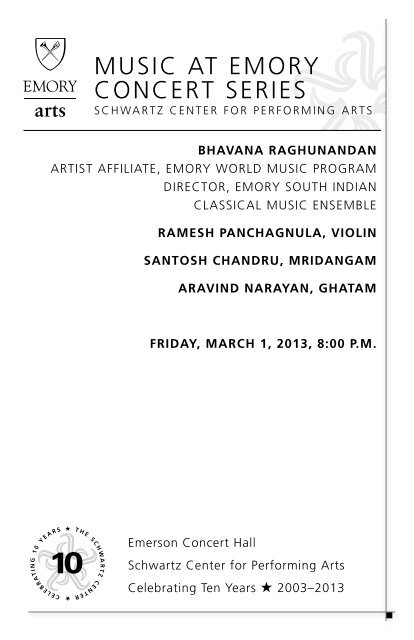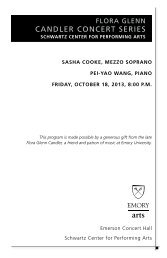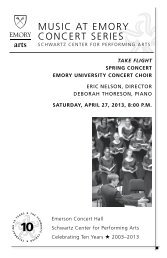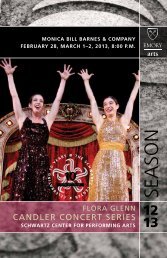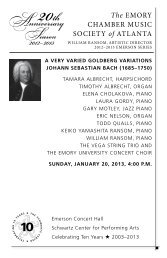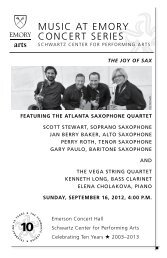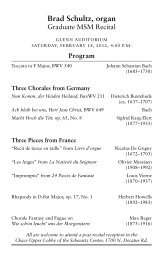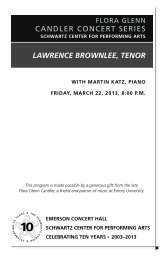music at emory concert series - Arts at Emory
music at emory concert series - Arts at Emory
music at emory concert series - Arts at Emory
You also want an ePaper? Increase the reach of your titles
YUMPU automatically turns print PDFs into web optimized ePapers that Google loves.
<strong>music</strong> <strong>at</strong> <strong>emory</strong><br />
<strong>concert</strong> <strong>series</strong><br />
schwartz center for performing arts<br />
Bhavana Raghunandan<br />
artist affili<strong>at</strong>e, <strong>emory</strong> world <strong>music</strong> program<br />
director, <strong>emory</strong> south indian<br />
classical <strong>music</strong> ensemble<br />
Ramesh Panchagnula, violin<br />
santosh chandRu, mRidangam<br />
aRavind naRayan, gh<strong>at</strong>am<br />
fRiday, maRch 1, 2013, 8:00 P.m.<br />
emerson <strong>concert</strong> hall<br />
schwartz center for performing arts<br />
celebr<strong>at</strong>ing ten years h 2003–2013
1. varnam<br />
program<br />
Ragam: saveri (15th mela janyam)<br />
talam: adi<br />
composer: Kotthavaasal Venk<strong>at</strong>rama iyer<br />
Pallavi: sarasudaa ninne Kori chaalaa marulu Konnadira<br />
O ardent lover! She is extremely tormented because of her longing for you<br />
anupallavi: girini Velayu sree Venk<strong>at</strong>eshaa Karunincha ide samayamu<br />
O venk<strong>at</strong>esa! You, who dwell on the pinnacle of the hills, please heed th<strong>at</strong><br />
now is the time to show compassion.<br />
charanam: daanipai nenaruna eevela<br />
Please show affection on the poor being this very instant.<br />
2. ganap<strong>at</strong>he maham<strong>at</strong>he<br />
Ragam: Kalyani<br />
talam: roopakam<br />
composer: muttuswami dikshitar<br />
Pallavi: ganap<strong>at</strong>e maham<strong>at</strong>e, gowri kumara mam pahi<br />
O revered Ganap<strong>at</strong>hi, son of Parv<strong>at</strong>hi please protect me<br />
anupallavi: animadyastaiswarya prada guruguha pujita vara<br />
charanam: soma suryagni netra ,sadasivananda putra vamadevadi<br />
vaktra, varija gambhira g<strong>at</strong>ra m-Kaala himadrija sudhamoda hiranmaya<br />
pithastitha pamara pandita nuta vara pankajasanadi nuta<br />
3. chittam irangada denayya<br />
Ragam: sahana<br />
talam: misra chapu<br />
composer: papanasan sivan<br />
Pallavi: cittam irangadenayya sendil velayya nin cittam<br />
irangadenayya siriyenidam aru mamukha siridenum nin<br />
Oh wielder of the mighty spear (vElayyA), resident of tiruccendUr (sendil)!<br />
Why is your (nin) heart (cittam) not melting (irangAdEnayyA) even a bit<br />
(siridEnum) <strong>at</strong> the plight of this insignificant (siriyEniDam), lowly devotee of<br />
yours, Oh lord with six (Aru) mighty (mA) faces<br />
anupallavi: bhaktark-kirangum dina bandhu enrunnai nambi paghal<br />
iravum panindu pddi bhajikkum enpal nin<br />
Why is your (nin) heart (cittam) not melting (irangAdEnayyA) even a bit<br />
(siridEnum) <strong>at</strong> the plight of this insignificant (siriyEniDam), lowly devotee<br />
of yours, Oh lord with six (Aru) mighty (mA) faces (mukhA)? For, have I<br />
not always believed (nambi) in you (unnai) as (enru) the friend/companion<br />
(bandhu) of the destitute (dIna) who is very compassion<strong>at</strong>e (irangum) towards<br />
his (nin) devotees (bhaktarukku)?<br />
2
charanam: talaiyil malai vizhndalum tanga sanmukhan undenrulagam<br />
ariya undan tiruvadi adaindene malaiyo en vinai undan karunaittuli irundal<br />
vaiyam viyakka ramadasan tannai raksikka nin<br />
I have <strong>at</strong>tained (aDaindEnE) the refuge of your (undan) divine (tiru) feet (aDi)<br />
with the assurance th<strong>at</strong> even if a huge mountain (malai) fell (vizhundAlum) on<br />
top of my head (talaiyil), you, the six-faced one (SaNmukhan), will be there<br />
(uNDu enru) to protect me, who worships (paNindu) and sings (pADi) your<br />
praises (bhajikkum) day (pagal) and night (iravum), by bearing the weight<br />
(tAnga) of my cross, to the acknowledgment (ariya) of the whole world<br />
(ulagam). Even if my cross (vinai) is as huge as a mountain, the universe<br />
(vaiyyam) will be amazed (viyakka) by how (irundAl) a tiny bit (tuLi) of your<br />
(undan) compassion (karuNai) will destroy it, as you protect me (tanai),<br />
rAmadAsan! (So, why is your (nin) heart (cittam) not melting (irangAdEnayyA)<br />
even a bit (siridEnum) <strong>at</strong> the plight of this insignificant (siriyEniDam), lowly<br />
devotee of yours, Oh lord with six (Aru) mighty (mA) faces (mukhA)<br />
4. Baagaayanayya<br />
Ragam: chandrajyothi<br />
talam: deshaadi<br />
composer: tyagaraja<br />
language: telugu<br />
Pallavi: bagayanayya ni maya lento; brahmakaina koniyada tarama<br />
(bagaya)<br />
Your little miraculous tricks are so amazing, no one, not even Brahma, can<br />
understand and describe and praise them adequ<strong>at</strong>ely.<br />
anupallavi: ee garadamunu yonarincucunu ne gadanucu balkutayu<br />
(bagaya)<br />
After cre<strong>at</strong>ing all the maaya (illusion), you then claim you had nothing to do<br />
with them!<br />
charanam: alanadu kauravula nanaca mana yalari dosamanu naruni<br />
juci, papa phalamu niku danaku ledani cakkaga palanamu seya leda?<br />
tyagarajanuta<br />
Once upon a time, when you asked Arjuna, a human, to destroy the<br />
Kauravas, he agonized saying it would be a sin. You, NaaraayaNaa assured<br />
him th<strong>at</strong> the effects of th<strong>at</strong> destruction would not be a sin th<strong>at</strong> would<br />
adversely affect him, and you gave him salv<strong>at</strong>ion.<br />
5. marivere dikkevaraiya<br />
Ragam: shanmukhapriya<br />
talam: adi<br />
composer: p<strong>at</strong>nam subramanya iyer<br />
language:<br />
3
Pallavi: marivere dikkevarayya rama ma<strong>at</strong>i ma<strong>at</strong>ikini telupavalena<br />
besides you, who will save me, Rama, how many times need I tell you?<br />
anupallavi : daridaapu leni naa jaali terci dayacesi broce dora neevu kaada<br />
Aren’t you the one who, being near me, rids me of my troubles, and, with<br />
your grace, protects me<br />
charanam: ninnu caala nammi unnavaadanucu nee chittamunake telisi<br />
undagaa sannutaanga shree venk<strong>at</strong>esha neevu nannu brovakayunduta<br />
nyayama<br />
You with your gre<strong>at</strong> mind, don’t you know those who place implicit trust in<br />
you You, who are praised by all as the gre<strong>at</strong> Lord Venk<strong>at</strong>eshwara, is it just<br />
th<strong>at</strong> you do not come to save me?<br />
6. tirup<strong>at</strong>hi venk<strong>at</strong>aramana<br />
talam: aadi<br />
composer: purandara dasa<br />
language: Kannada<br />
Pallavi: tirup<strong>at</strong>i venk<strong>at</strong>aramana ninagy<strong>at</strong>ake baradu karuna<br />
Oh! Venk<strong>at</strong>esha why don’t you show mercy!<br />
anupallavi: nambide ninnaya carana paripalisa beko karuna<br />
I have believed in you, please bless me and protect me.<br />
charanam 1: alagiriyindalli banda svami anjanagiriyali ninda kolalu<br />
dhvaniyudo canda namma kundalaraya mukunda<br />
Oh! the one who has come from Alagiri and stood on the Anjanadri hills, the<br />
<strong>music</strong> from your flute is so beautiful Oh! Mukunda<br />
charanam 2: mudala giriyali ninda muddu venk<strong>at</strong>ap<strong>at</strong>i balavanta idilla<br />
ninage shrikanta irelu lokakananta<br />
Oh! the one standing on the Moodala hills you are stronger than any other<br />
god. There is no one comparable to you in this whole world Oh! Sreekantha.<br />
charanam 3: papa vinashini snana hari padodakave pana kopa tapagala<br />
nidhana namma purandara vittalana dhyana<br />
The one who removes all sins just by having a b<strong>at</strong>h in Papavinashini falls,<br />
which is born <strong>at</strong> your feet, Your thought itself removes our anger and pride<br />
Oh! Purandara Vittala<br />
7. smarane sukamu<br />
Ragam: Janaranajani<br />
talam: deshaadi<br />
composer: tyagaraja<br />
language: telugu<br />
Pallavi: smarane sukhamu rama nama narudai butti nanduku nama<br />
For having been born as a human being, remembrance of name of Lord Sri<br />
Rama only is the true comfort.<br />
4
anupallavi: vara rajayoga nistulau varikanand mand<strong>at</strong><strong>at</strong>tu<br />
In the same manner as bliss accrues to those who remain firmly established in<br />
the blessed Raja Yoga, for having been born as a human being, remembrance<br />
of the name of Lord Sri Rama only is the true comfort<br />
charanam: rama nama shravanamu valla nama rupame hrdayamu nindi<br />
prema butta seyaga leda niskama tyagaraju seyu nama<br />
Isn’t it th<strong>at</strong> because of listening to the name of Sri Rama, the very form of<br />
the name, having filled the heart, enabled to gener<strong>at</strong>e pure love towards the<br />
Lord? Therefore, for having been born as a human being, remembrance of<br />
the name of Lord Sri Rama, without desires, as done by this Tyagaraja, is the<br />
true comfort.<br />
8. Ragam-tanam-Pallavi:<br />
ragam thanam pallavi is a form of singing in carn<strong>at</strong>ic <strong>music</strong> th<strong>at</strong> allows the<br />
<strong>music</strong>ians to improvise to a gre<strong>at</strong> extent. it is one of the most complete aspects<br />
of classical <strong>music</strong>, demonstr<strong>at</strong>ing the entire gamut of talents and the depth of<br />
knowledge of the <strong>music</strong>ian. “ragam” in the context refers to ragaalapana—the<br />
first component. in this form of pure melodic improvis<strong>at</strong>ion, the <strong>music</strong>ian starts<br />
with a refrain to cre<strong>at</strong>e the mood of raga and lays a found<strong>at</strong>ion for composition<br />
to follow. thanam is one of the most important forms of improvis<strong>at</strong>ion, and<br />
it is integral to ragam thanam pallavi. it is the second component of this<br />
composite form of improvis<strong>at</strong>ion. originally developed for the Veena, it consists<br />
of expanding the raga with syllables like tha, nam, thom, aa, nom, and na.<br />
thanam is a rhythmic version of the raga alaapana. although tanam is often<br />
rendered without percussion support, the element of rhythm is more obvious<br />
in this type of improvis<strong>at</strong>ion. the pallavi is usually a one-line composition set to<br />
a single cycle of tala. the tala could range from the simple to the complex, and<br />
there may also be different g<strong>at</strong>is being employed.<br />
pallavi has two portions to it. the first half of pallavi is an ascending piece<br />
of notes and the first half of the pallavi should always end <strong>at</strong> the strike of the<br />
beginning of the second half of the talam cycle, called the ardhi. between<br />
the first half of the pallavi and the second half of the pallavi, there will be a<br />
brief pause called as the Vishranthi, and then the second portion of the pallavi<br />
starts. executing niraval for a pallavi is unique, as, unlike in a krithi, the artist is<br />
not allowed to change the loc<strong>at</strong>ions of each syllable in the sahithyam, as this<br />
lessens the inn<strong>at</strong>e beauty of the pallavi. the basic style in pallavi rendition is to<br />
sing the pallavi in different speeds or nadai. in most cases the pallavi is set to<br />
ch<strong>at</strong>hushtra nadai meaning each be<strong>at</strong> carries four units. the singer will then<br />
sing the pallavi in three different speeds, once with each be<strong>at</strong> carrying one<br />
unit, then two units, and then four units per be<strong>at</strong>. once this is completed,<br />
they would sing the pallavi in a different nadai called tisra nadai, meaning<br />
each be<strong>at</strong> now carries three units. once these aspects are covered, the singer<br />
explores in the Kalpanaswara phase, and they would start exploring different<br />
ragas during the Kalpanaswara.<br />
5
venk<strong>at</strong>a shaila vihaara vegame Brovaraara<br />
oh the one who dwells on the Venk<strong>at</strong>a mountains please come soon to bless<br />
me<br />
9. entha ma<strong>at</strong>hramuna<br />
Ragam: raagamaalikaa<br />
talam: mishra caapu<br />
composer: annamacharya<br />
language: telugu<br />
Pallavi (Ragam: Brindaavani) enta ma<strong>at</strong>ramuna evvaru talacina anta<br />
ma<strong>at</strong>rame neevoo anta raantaramu| lencee cooda pindante nippadi<br />
enna<strong>at</strong>loo<br />
Oh Venk<strong>at</strong>ap<strong>at</strong>i, your presence and grace depend upon how well a person<br />
thinks about you. When I observe sincerely, it is just like the size and quality<br />
of a pancake depending on the b<strong>at</strong>ter.<br />
anupallavi (same raagam) koluturumimu vyshnavuloo koorimito<br />
vishnudanee palukuturoomimu vedaantulu parabrahma vanusu tal<strong>at</strong>urumimu<br />
shaivuloo takina bhaktulanoo shivudanusoo alaripok<strong>at</strong>uturu kaapaaliku<br />
laadibhyravundanusoo<br />
The Vaishnavas worship you with reverence as Vishnu. The Vedic philosophers<br />
tell th<strong>at</strong> you are the Supreme Conscience. The Saivas believe th<strong>at</strong> you are Siva<br />
and the Kapalikas praise you as Adibhairava.<br />
charanam (Ragam: mayamalavagowla) sarinennuturu<br />
shaakteyuloo shaktiroopu neevanusu, dari- shanamulamimu naalaavidulanu<br />
talapula kol<strong>at</strong>ula bajinturoo sirulu mamane alpa buddhi tala- cina vaariki<br />
alpamba vuduvoo garimala mimune ganamani tala- cina ganabuddhulaku<br />
ganudavoo nee valana kor<strong>at</strong>e ledumari neeru kor<strong>at</strong>i taamaravoo aa- vala<br />
bhaageer<strong>at</strong>i tari bhaavula aajalame oorina yetloo shree venk<strong>at</strong>ap<strong>at</strong>i nee<br />
vyde danu cekoni vunna daivamani eevalane nee sharana nedunu itiye<br />
par<strong>at</strong><strong>at</strong>vamunaaku itiye par<strong>at</strong><strong>at</strong>vamunaaku itiye par<strong>at</strong><strong>at</strong>vamunaaku,<br />
The Sakteyas consider you as the manifest<strong>at</strong>ion of the supreme power Shakti.<br />
People chant your praise in a number of ways. Ignorant people assume th<strong>at</strong><br />
you are insignificant. The wise recognise your infinite gre<strong>at</strong>ness. You are<br />
like the vast w<strong>at</strong>er pool to spread the lotus flowers. It is only the w<strong>at</strong>er of<br />
Bhagiradhi river th<strong>at</strong> seeps into the wells by her side. Oh Sri Venk<strong>at</strong>ap<strong>at</strong>i, you<br />
are our protector. I surrender <strong>at</strong> your feet. It is transcendental bliss for me.<br />
10. tillana<br />
Ragam: poorvi rupaka<br />
talam: adi<br />
composer: t. Vaidyan<strong>at</strong>ha bhagav<strong>at</strong>ar<br />
Pallavi: ni ri ni ri ga ma ga ri sa ni ri ga ma dha ma ga ri ma ga ri sa ni<br />
ri ga ma dha ma dha ni ni ma dha dha ga ma dha ma ga ri sa ni anupallavi:<br />
6
ni ri ga ma dha ma dha dha sa ma dha sa ni ri ni dha ma dha sa ni ga ri ni ri<br />
ni dha ni dha ma dha dha ri ri ri ni dha ma dha ma ga ri sa nadhru tanitom<br />
tomdhru tanitom udara nadara tani tani udarana dani tom (3 times)<br />
dhitlam kit<strong>at</strong>ak<strong>at</strong>om dhitlam kit<strong>at</strong>ak<strong>at</strong>om dhilam kit<strong>at</strong>ak<strong>at</strong>om (3 times)<br />
charanam: nisada risabha gandhara madhyama shadja<br />
pancamoddh<strong>at</strong>anut<strong>at</strong>a svarita prajaya pranavakara nitya niramaya nirmala<br />
nigamanta pr<strong>at</strong>ibhava nirupama niravadhi sukhada girisha niradha niranjani<br />
nirguna brahm<strong>at</strong>ri nadhru tanitom tomdhru tanitom<br />
Bhavana raghunandan<br />
bhavana raghunandan is an accomplished carn<strong>at</strong>ic <strong>music</strong>ian and bharta<br />
n<strong>at</strong>yam dancer. she has a master’s degree in carn<strong>at</strong>ic <strong>music</strong> from the university<br />
of madras. bhavana has performed many duet <strong>concert</strong>s through the years in<br />
india with lakshmi Varun and solo voice <strong>concert</strong>s througout the united st<strong>at</strong>es.<br />
bhavana began her studies with her mother, padmamalini raghunandan,<br />
and continued her <strong>music</strong>al journey with Koviladi mahwaprasad and anoor<br />
ananthakrishna sharma, and she is now under the guidance of renowned<br />
<strong>music</strong>an chitraveena ravikiran. bhavana is a graded artist of all india radio<br />
and is titled “ramanuja paaduka sevaka” for her contribution in the field<br />
of carn<strong>at</strong>ic <strong>music</strong> from his holiness sri ramanuja acharyar of mudaliandan<br />
ashram. bhavana holds a guiness record for particip<strong>at</strong>ing in the lakshagala<br />
sankeertanaarchana, which was considered the largest choir group. bhavana<br />
was trained in bhar<strong>at</strong>a n<strong>at</strong>yam under malini ravikshankar and anuradha<br />
Vikranth.<br />
bhavana is cofounder of Kalavardhini india, an institution of fine arts in<br />
india. she provides vocal support to bharta n<strong>at</strong>yam and Kuchipudi programs<br />
and arangetrams. bhavana’s main objectives are to learn, train, and contribute<br />
to the beautiful world of carn<strong>at</strong>ic <strong>music</strong> and dance by giving vocal <strong>concert</strong>s<br />
and bhar<strong>at</strong>an<strong>at</strong>yam programs. she also plays violin and veena.<br />
bhavana has given guest lectures <strong>at</strong> <strong>emory</strong>, she serves as its artist affili<strong>at</strong>e<br />
teaching carn<strong>at</strong>ic <strong>music</strong>, and she is the director of the <strong>emory</strong> south indian<br />
classical <strong>music</strong> ensemble. bhavana teaches vocal <strong>music</strong> and bharta n<strong>at</strong>yam <strong>at</strong><br />
Kalaivani and also instructs <strong>music</strong> lessons over skype.<br />
ramesh panchagnula, violin<br />
ramesh panchagnula is a disciple of renowned vocalist and violinist Vidwan<br />
l<strong>at</strong>e sri neti srirama sarma garu of hyderabad, who is a direct disciple of<br />
the legendary sri parupalli ramakrishnayya pantulu of Vijayawada. ramesh has<br />
been trained in the carn<strong>at</strong>ic classical style of <strong>music</strong> for more than fifteen years.<br />
after moving to the united st<strong>at</strong>es, he continued learning from shivkumar<br />
Kalyanaraman <strong>at</strong> rensselaer polytechnic institute (rpi) in troy, new york.<br />
7
amesh has accompanied several visiting artists in the united st<strong>at</strong>es, and he<br />
has also given solo violin <strong>concert</strong>s in india. he was an auditioned violinist <strong>at</strong> the<br />
all india radio, hyderabad, and was a regular live performer in the instrumental<br />
carn<strong>at</strong>ic <strong>music</strong> <strong>concert</strong> <strong>series</strong>. he has accompanied several Kuchipudi dance<br />
ballets by smt. sasikala penumarthi and smt. rev<strong>at</strong>hi Komanduri. he also<br />
performed lead melody in thala vaadya kutcheris (percussion ensembles)<br />
conducted by guru sri. t. s. nandakumar. ramesh has been an invited<br />
performing artist with the <strong>emory</strong> south indian classical <strong>music</strong> ensemble for the<br />
past several years and also directed the ensemble for two years.<br />
ramesh has a master’s degree in electrical engineering from rpi. he works<br />
as senior video engineer for arris group inc. in <strong>at</strong>lanta.<br />
santosh chandru, mridangam<br />
one of the foremost disciples of guru sri t. s. nandakumar, santosh chandru<br />
has been playing the mridangam since age eleven. he has been accompanying<br />
various leading artists in the fields of both dance and <strong>music</strong> for many years, and<br />
he is a graded artist of the all india radio.<br />
santosh has been a part of numerous thaala Vaadya K<strong>at</strong>cheris (rhythm<br />
ensembles) along with his guru, including performances <strong>at</strong> the prestigious<br />
cleveland thyagaraja aradhana festival. he has also been a part of lecture<br />
demonstr<strong>at</strong>ions by his guru <strong>at</strong> various universities in the united st<strong>at</strong>es. he is a<br />
regular accompanist for padma bhushan dr. K. J. yesudas during his classical<br />
<strong>concert</strong>s in the united st<strong>at</strong>es. he has accompanied various other prominent<br />
artists such as mahanadhi shobana, sankaran namboothiri, and flute V. K.<br />
raman to name a few. santosh has also accompanied senior disciples of artists<br />
such as palgh<strong>at</strong> sri K. V. narayanaswamy, prof t. r. subramaniam, and sri<br />
neyveli santhanagopalan. he has had the opportunity to work with leading<br />
artists such as tiruvarur bhaktav<strong>at</strong>salam, embar Kannan, flute g. s. rajan, and<br />
b. u. ganesh prasad, among others.<br />
santosh has provided able mridangam support for many classical dance<br />
forms like bhar<strong>at</strong>an<strong>at</strong>yam, Kuchipudi, and mohini<strong>at</strong>tam. he has been part<br />
of dance ballets such as ramayana, shiva shakti, and dashav<strong>at</strong>haram, and<br />
special dance projects such as panchabhootam in <strong>at</strong>lanta and festival of india<br />
<strong>at</strong> carnegie hall, new york.<br />
santosh has been an invited performing artist for many of <strong>emory</strong>’s world<br />
<strong>music</strong> ensembles. he teaches mridangam in <strong>at</strong>lanta and has nurtured many<br />
students, some of whom have started accompanying for <strong>concert</strong>s.<br />
academically, santosh has double master’s degrees in chemical engineering<br />
and environmental engineering, and he works for an environmental consulting<br />
group in <strong>at</strong>lanta.<br />
8
aravind narayan, gh<strong>at</strong>am<br />
arvind narayan is a first-year student <strong>at</strong> the georgia institute of technology<br />
studying mechanical engineering and discrete m<strong>at</strong>hem<strong>at</strong>ics. he has been<br />
learning mridangam since he was eight years old. arvind started under subra<br />
Vishwan<strong>at</strong>han. he l<strong>at</strong>er took lessons from guruswamy. he currently studies<br />
with santosh chandru, with whom he has been for five years.<br />
arvind is a regular performer <strong>at</strong> several local <strong>concert</strong>s and events. he has<br />
accompanied artists <strong>at</strong> multiple venues, including the 2009 fetna program,<br />
the camaga composer’s day program, and the nashville aradhana. in the<br />
2011 cleveland aradhana, arvind performed in a tala Vadyam (percussion<br />
ensemble) along with santosh and santosh’s guru t. s. nandakumar.<br />
arvind is also part of a fusion <strong>music</strong> group <strong>at</strong> georgia tech called pb&J. the<br />
group blends <strong>music</strong> from indian classical, bollywood, and western styles, and<br />
they have performed <strong>at</strong> the 2012 diwali dinner event, as well as <strong>at</strong> the 2013<br />
intern<strong>at</strong>ional harmony event. pb&J will also hold its own <strong>concert</strong> in april.<br />
arvind hopes to continue playing mridangam through college and in the<br />
future. he would like to teach when he is older to spread his art.<br />
arts <strong>at</strong> <strong>emory</strong> box office/audience inform<strong>at</strong>ion<br />
404.727.5050 • arts.<strong>emory</strong>.edu<br />
in consideR<strong>at</strong>ion foR otheR members of the audience, please turn off all pagers and phones.<br />
photographs and recordings may not be made during a performance without advance permission.<br />
the cough dRoPs in the lobby are courtesy of margery and robert mcKay.<br />
usheRs aRe memBeRs of <strong>music</strong> <strong>at</strong> <strong>emory</strong> Volunteers and alpha phi omega, a n<strong>at</strong>ional service and<br />
social fr<strong>at</strong>ernity. call 404.727.6640 for inform<strong>at</strong>ion about ushering.<br />
fRequently uPd<strong>at</strong>ed event and program inform<strong>at</strong>ion available online <strong>at</strong> arts.<strong>emory</strong>.edu.<br />
facebook.com/<strong>emory</strong>arts<br />
twitter.com/<strong>emory</strong>arts<br />
9


